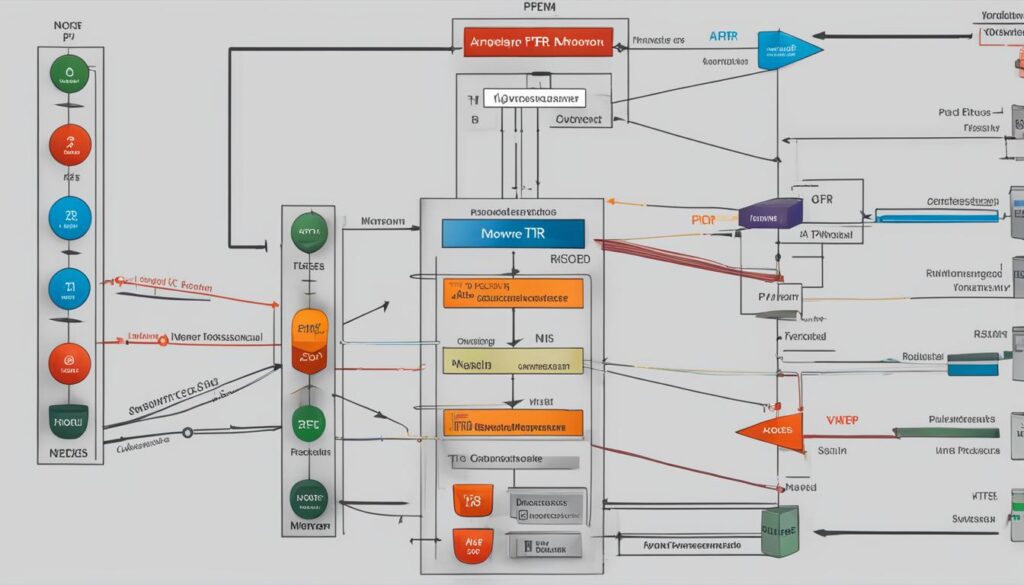Are you confused about what PTR means in information technology? Want to know the definition and acronym of PTR? Look no further! In this article, we will delve into the world of PTR records and explain their significance in the IT industry.
A PTR record, or pointer record, is a DNS record that plays a vital role in authenticating connections and filtering out spam. It resolves an IP address to a domain name, establishing trust for servers. This reverse DNS lookup is commonly used in mail servers to verify the identity of servers and reduce spam.
Contents
- 1 How PTR Works
- 2 Importance of PTR Records
- 3 Troubleshooting PTR Records
- 4 Best Practices for PTR Records
- 5 Learn More About DNS
- 6 Conclusion
- 7 FAQ
- 7.1 What is a PTR record?
- 7.2 How does a PTR record work?
- 7.3 What is the importance of PTR records?
- 7.4 How do I set up PTR records?
- 7.5 What are common issues with PTR records?
- 7.6 What are the best practices for PTR records?
- 7.7 How can I learn more about DNS?
- 7.8 What is the importance of understanding PTR in IT?
- 8 Source Links
Key Takeaways:
- PTR stands for Pointer Record, and it is a DNS record used to resolve an IP address to a domain name.
- PTR records are essential for establishing trust and authenticity in digital communication, particularly in email servers.
- They play a crucial role in reducing spam and verifying the identity of servers.
- PTR records are not created with your domain’s DNS provider but with the entity that controls your public IP addresses.
- Following best practices for PTR records, including accuracy and documentation, is essential for maintaining reliable mail deliverability.
How PTR Works
A PTR record plays a crucial role in information technology, particularly in the Domain Name System (DNS). This record performs a reverse lookup, translating an IP address into a domain name. By knowing the formal domain name associated with an IP address, you can achieve various objectives, including validation, safety, and investigation.
Every computer has a unique IP address, and the PTR record allows you to identify the corresponding domain name. This information is invaluable when it comes to validating the legitimacy of connections, ensuring safety measures are in place, and investigating network activity.
PTR records are stored under the IP address in both IPv4 and IPv6 formats. In the case of IPv4, the IP address is written backward, followed by the “.in-addr.arpa” domain. As for IPv6, the IP address is divided into four-bit sections and labeled with “.ip6.arpa”. The use of PTR records in both IPv4 and IPv6 formats showcases its ubiquity in the IT landscape.
To grasp a better understanding of how PTR works, let’s visualize the process with the following example:
“Imagine you have an IP address of 192.0.2.99. By performing a reverse lookup with the corresponding PTR record, you can determine the domain name associated with the IP address. In this case, the PTR record might reveal that the IP address 192.0.2.99 maps to the domain name example.com.”
The reverse lookup process facilitated by the PTR record is essential for establishing trust and authenticity in digital communication. It provides a mechanism to verify the identity of servers and reduce the occurrence of spam. Additionally, PTR records are commonly used in mail servers to authenticate connections and filter out illegitimate messages.
To visualize the importance of PTR records, let’s take a look at the following table:
| Benefits of PTR Records | Explanation |
|---|---|
| Server Authentication | PTR records verify the identity of servers, ensuring trustworthy connections. |
| Spam Reduction | By authenticating connections, PTR records help filter out spam and illegitimate messages. |
| Safety Measures | PTR records contribute to overall safety by validating communication partners. |
| Investigation Support | These records assist in investigating the origin of network activity. |
Understanding how PTR works and its significance in the technology landscape is vital for anyone involved in managing IT infrastructure, particularly mail servers. By configuring and maintaining PTR records correctly, you can establish trust, reduce spam, and ensure the smooth flow of digital communication.
Importance of PTR Records
When it comes to digital communication, PTR records play a crucial role in establishing trust and authenticity, particularly in email servers. These records serve as a validation method, verifying the identity of the server and ensuring that incoming messages are accepted by some email servers.
But why are PTR records so important? Let’s take a closer look:
Safeguarding Communication
PTR records are essential for safety purposes as they ensure that communication partners have properly configured PTR records. By having these records in place, organizations can reduce the risk of phishing attacks and other malicious activities that exploit vulnerabilities in email systems.
Evidence in Investigations
Another significant aspect of PTR records is their usefulness in investigations. These records provide valuable information for understanding the origin of network traffic. Whether it’s tracking down the source of suspicious activity or identifying the destination of data packets, PTR records can assist in analyzing and uncovering relevant details.
Enhancing Mail Deliverability
To maintain smooth email flow, some email servers require proper PTR records for message acceptance. These records act as an additional layer of authentication, ensuring that the server sending the email is legitimate and trustworthy. By having a correctly configured PTR record, organizations can enhance their mail deliverability rates and avoid being flagged as potential spam senders.
Overall, PTR records are integral to establishing trust, minimizing risks, and fostering secure and reliable digital communication.

Remember, PTR records play a vital role in verifying the identity of servers and establishing trust in digital communication. By setting them up correctly and maintaining accurate documentation, you can ensure smooth communication and reduce the chances of any mail delivery issues.
Troubleshooting PTR Records
When it comes to PTR records, there are a few common issues that you may encounter. It’s important to be aware of these issues and know how to troubleshoot them effectively. Here are some of the most common problems associated with PTR records:
- Incorrect information in the record itself
- Propagation delays
- Trust verification
If you suspect any issues with your PTR record, it’s advisable to perform a test lookup to verify its accuracy. This will help you identify any potential errors or discrepancies.
If you find any typographical errors in the PTR record, it’s crucial to correct them promptly. Even a small mistake can cause significant issues with mail deliverability and server authentication.
Keep in mind that DNS records can take time to propagate. It’s important to allow sufficient time for changes to take effect. Patience is key, as propagation delays can sometimes cause temporary inconvenience.
If you have gone through the troubleshooting steps and the issues persist, it’s recommended to reach out to the provider that controls your IP addresses. They can offer technical assistance and help resolve any lingering problems.
| Common Issues | Troubleshooting Steps |
|---|---|
| Incorrect information in the record | Check the PTR record for any typographical errors Verify the accuracy of the domain name and IP address |
| Propagation delays | Allow sufficient time for changes to propagate Contact your DNS provider for assistance if delays persist |
| Trust verification | Ensure that the PTR record is properly authenticated Consider reaching out to the provider controlling your IP addresses for guidance |
By following these troubleshooting steps and staying vigilant, you can address any issues that arise with your PTR records and ensure smooth communication and authentication for your servers.

Best Practices for PTR Records
To ensure smooth functioning and maintain mail deliverability, it is important to follow best practices for PTR records. Accuracy is key, as any typos in the record can cause issues. It is recommended to create and maintain documentation for all DNS records, including PTR records, to avoid forgetting important details. When migrating hosting providers or changing IP addresses, updating the PTR records is crucial. By adhering to these best practices, you can ensure the timely and safe delivery of outbound messages.
Best Practices for PTR Records
When it comes to PTR records, attention to detail is essential. Follow these best practices to ensure seamless operation and reliable mail delivery:
- Create Accurate PTR Records: Double-check the information in your PTR records to avoid any inaccuracies. Even minor typos can cause disruption in email delivery. It is recommended to review and validate the PTR record for accuracy regularly.
- Maintain Documentation: Keep a record of all DNS configurations, including the PTR records. Having documentation readily available will help you quickly troubleshoot any issues and ensure consistency across your DNS settings.
- Update PTR Records when Migrating or Changing IPs: If you move your hosting to a new provider or change your IP addresses, it is crucial to update the PTR records accordingly. This ensures that the reverse lookup correctly identifies your domain name and maintains trust in your server’s identity.
By following these best practices, you can optimize your PTR record management, reduce the risk of errors, and maintain the integrity of your email communication.
| Best Practice | Description |
|---|---|
| Create Accurate PTR Records | Double-check the information in your PTR records and ensure they are error-free. |
| Maintain Documentation | Keep records of all DNS configurations, including PTR records. |
| Update PTR Records when Migrating or Changing IPs | Make sure to update PTR records when migrating hosting providers or changing IP addresses. |
Learn More About DNS
DNS (Domain Name System) is a critical component of effective internet communication. While understanding DNS terminology may require some time and practice, there are training resources available to help you expand your knowledge. One such resource is Keith Barker’s training on the CompTIA Network+ certification, which covers various essential networking topics, including DNS. By investing in your understanding of DNS, you can navigate and comprehend this crucial aspect of the digital world.
Below is a quote from Keith Barker:
“DNS plays a vital role in ensuring that internet communication flows smoothly. By learning about DNS terminology, you will gain insights into how it functions and how to troubleshoot any issues that may arise. It’s an essential skill for anyone involved in IT or network administration.”
Key DNS Terminology
Expand your understanding of DNS by familiarizing yourself with the following key terminology:
- Domain Name System (DNS): The hierarchical naming system that translates domain names into IP addresses.
- Domain Name: A user-friendly name used to identify a website or resource on the internet (e.g., www.example.com).
- IP Address: A unique numerical label assigned to each device connected to a computer network.
- Name Server: A server responsible for storing and managing DNS records.
- Resolver: A program or server that queries DNS servers to provide IP address resolutions.
Improve your DNS knowledge with the following table, which outlines some commonly used DNS terminology:
| Term | Definition |
|---|---|
| DNS Zone | A portion of the DNS namespace that is managed by a specific entity or organization. |
| TTL (Time-to-Live) | The length of time a DNS record is valid and can be cached by resolvers. |
| Authoritative Name Server | A DNS server that has the original and official DNS records for a specific domain. |
| MX Record | A DNS resource record that specifies the mail server responsible for accepting incoming email for a domain. |
By familiarizing yourself with DNS terminology, you’ll gain a deeper understanding of how DNS works and how it impacts various aspects of internet communication.

Keep exploring the world of DNS to enhance your knowledge and technical capabilities in the dynamic digital landscape.
Conclusion
PTR records, or pointer records, are an integral part of information technology, specifically in the Domain Name System (DNS). These records allow for the reverse lookup of an IP address to a domain name, providing authentication and trust verification for servers. By understanding how PTR works, its importance, and how to properly set up and troubleshoot PTR records, you can ensure the smooth functioning of your digital communication and maintain mail deliverability.
With PTR records, you can establish trust and authenticity in your digital communication. They play a crucial role in email servers, where some providers require proper PTR records to accept incoming messages. By verifying the identity of servers, PTR records help reduce spam and ensure safety in your communications.
Setting up PTR records requires attention to detail and accuracy. It is essential to work with the entity that controls your public IP addresses, such as your internet service provider or cloud provider, to configure PTR records correctly. By following best practices, such as maintaining accurate documentation and promptly updating PTR records when necessary, you can ensure the proper functioning of your mail server and the successful delivery of outbound messages.
FAQ
What is a PTR record?
A PTR record, or pointer record, is a DNS record that resolves an IP address to a domain name.
How does a PTR record work?
A PTR record performs a reverse lookup in the Domain Name System (DNS), translating an IP address into a domain name.
What is the importance of PTR records?
PTR records play a vital role in establishing trust and authenticity in digital communication, especially in email servers.
How do I set up PTR records?
PTR records are not created with your domain’s DNS provider but with the entity that controls your public IP addresses.
What are common issues with PTR records?
Common issues with PTR records include incorrect information in the record itself, propagation delays, and trust verification.
What are the best practices for PTR records?
To ensure smooth functioning and maintain mail deliverability, it is important to follow best practices for PTR records, such as accuracy and documentation.
How can I learn more about DNS?
To learn more about DNS and various other essential networking topics, there are training resources available.
What is the importance of understanding PTR in IT?
Understanding PTR in information technology is crucial for maintaining the smooth functioning of digital communication and mail deliverability.




